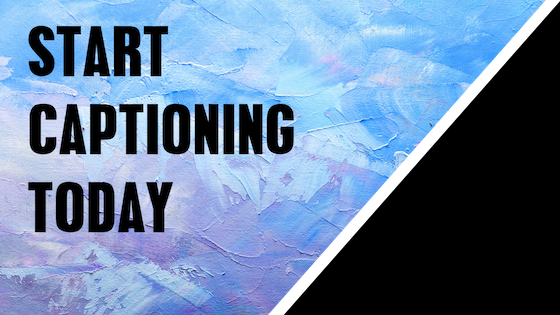How to Get Captioning Buy-In for Higher Education
Updated: June 3, 2019
Many people understand the value that captions can bring to higher education institutions, but they also realize that accessible captions don’t come free. The cost associated with captioning, whether it be through a third-party vendor or DIY methods, can make it difficult for accessibility advocates to convince higher-ups that implementing a captioning budget is worth it. We’re here to tell you that there’s hope.
Take out your toolbox because this post will equip you with the tools and techniques you need to petition for accessibility and to gain university buy-in for captioning.
State of Captioning
We recently published the 2019 State of Captioning report. This is a multi-industry report based on responses from a captioning trends survey. Respondents were asked to indicate their most significant barrier to captioning. Overall, 36% of respondents reported cost and budget as their greatest barrier to captioning, making it the top captioning barrier across all industries.

This fact was even more prevalent for the higher education industry, with 40% of higher education respondents reporting that cost and budget were the greatest captioning challenge to overcome.
Captioning is crucial for allowing students with disabilities to have access to educational video content, so establishing a captioning budget is very important for higher education. Getting buy-in is possible, and there are several tactics you can employ if your goal is to put a captioning budget in place.
How to Get Buy-In
It’s not often that accessibility advocates are in a position to implement a captioning budget and process at their institution. Therefore they must petition for captioning buy-in to those who are able to make that call. The question is, how?
Spread Accessibility Awareness
The first thing you can do as an accessibility advocate is to build awareness and to educate your organization.
Not everyone will be entirely familiar with accessibility or aware of how captioning can benefit an institution. Your goal should be to talk to people and to help them understand the basics of accessibility.
You can do this by hosting an accessibility workshop in which you pass out accessibility information and resources. You may even consider showing people what inaccessibility is like for people with disabilities. Try finding a video without captions, mute the audio, and see how much your coworkers get out of the video. They’ll realize that it’s difficult or nearly impossible to comprehend a video without sound and without accurate captions. This exercise is great because it helps instill empathy into your organization thus leading to more people who will vouch for captioning.

Show Why Captioning Is Worth the Money
The next thing you can do is show that captioning is worth the money; demonstrate the return on investment.
The most important benefit is that it makes content accessible, not only to deaf and hard of hearing people but to people with learning or cognitive disabilities, too. However, did you know that 80% of people who use captions aren’t deaf or hard of hearing? Many students utilize and find value in captions, regardless of not having a disability.
In 2016, Oregon State University conducted a study on perceptions and uses of captions and transcript from students in higher education. The study showed that the top reasons students use captions are to help them focus, to retain information, and to overcome poor audio quality. The bulk of student respondents indicated that they use captions as a learning aid, and 51% of qualitative answers were related to the use of closed captions to aid with comprehension. Captions improve the user and learning experience for all students.
In addition to using videos for learning purposes, universities often use video to showcase the culture of the school, the students, and the campus, to entice prospective students to learn more about the university. Improving organic search and SEO is excellent for colleges because it helps to draw more people to your site. Even video SEO can be improved, and adding captions is an effective way to rise in search engine ranks.
Search engine bots can’t watch a video the way a human can, so often they’re left to index a video based on the title or description alone. However, adding captions gives search engine bots the ability to read the text version of your video, enabling them to index and rank your videos more appropriately based on the actual content of the video.
Include accurate captions with your videos to improve your SEO and watch your video views and website visits increase.
Petition for a Pilot Program
After explaining the ROI of captioning to decision makers, they’ll start to see the real value of captioning. However, they may still be hesitant to put a full-on captioning program in motion. This is a great time to suggest a pilot captioning program.
The pilot program may consist of setting a small budget to caption a few videos using a third-party vendor or in-house methods. Before publishing the newly captioned videos, be sure to set a defined beginning and end date for the pilot program and to choose some metrics to track. These may include tracking video views, search engine ranks, and website visits.
It’s important to measure the impact of captioning on your organization’s videos by comparing the metrics from the captioned videos to other uncaptioned videos from your organization. Remember, the goal of the pilot program is to demonstrate how captions can bring value to your university.
The Cost of Captioning
Now that you know how to campaign for captioning buy-in let’s briefly discuss the costs associated with captioning. After all, the more knowledge you have about captioning, the more confident you’ll feel when you’re speaking about its value and benefits.
Depending on the scale of the video project, captioning costs can sometimes add up quickly. There are several ways to go about captioning, including using automatic speech recognition technology, in-house captioning methods, or third-party vendors.
Automatic Speech Recognition
Inaccurate captions are not great for students; 75.5% of students said that they use captions as a learning aid. Therefore it’s crucial that captions for educational content have limited errors.
Automatic speech recognition is a free tool on platforms like YouTube, but the inaccurate nature of automatic captions may end up costing you more. This is because automatic captions are only 60-70% accurate, and they need to be edited for accuracy to be legitimately accessible. This process requires a great deal of time and resources and is not very plausible for the number of videos that many universities use.
In-House and DIY Methods
Just like automatic captions – which don’t seem costly on the surface –in-house captioning costs can really add up. If you consider the cost of labor for transcription, synchronization, quality review, and management, the cost of an hour-long video can reach over $150. Of course, that number varies, but the takeaway is that in-house captioning isn’t free. The in-house method works for some universities, but often it isn’t budget friendly or sustainable at scale.
Third-Party Vendor
The third way to caption is to utilize a third-party captioning vendor. Using a captioning vendor requires the least amount of time commitment. Cost varies depending on the vendor, and most vendors charge anywhere from $1 to $15 per minute. Additional fees sometimes apply for other features, such as faster turnaround, translation, various caption file formats, and video platform integrations, and caption placement. These are all costs you can consider while keeping the volume of videos that need captioning in mind.
There are many to choose from, so be sure to do your due diligence and find a vendor that will serve your needs best. Some vendor features to look for are attentive support teams, user-friendly account systems, and truly accurate caption files.
The Time Is Now
Making an effort to provide accessible content now can save your organization money in the long run. In the past, organizations like Netflix, Hulu, MIT, and Harvard failed to caption their videos correctly and were sued for not making their content accessible. Many organizations who are sued end up paying for attorney expenses, damages, and other legal fees after arriving at court settlements.
Why Accessibility?
We’ve established that the main challenges for accessibility advocates in higher education are gaining support from decision makers at their institution and communicating the value of accessibility.
According to Thomas Tobin, author of Reach Everyone, Teach Everyone: Universal Design for Learning in Higher Education, those in leadership roles at universities care about three things: persistence, retention, and satisfaction. It’s important to reiterate that accessibility helps to support each of those things.
Captioning and accessible practices are often seen as something that is reserved for people with disabilities, but often only a small percentage of students at universities have a disability. Unfortunately, accessibility is often put on the back burner.
Rather than merely making accessible accommodations upon request, accessibility should be made a priority for students with disabilities. However, don’t forget that captions benefit all learners. Getting buy-in for captioning from decision-makers in higher education comes down to showing the value that they can provide to all students.
Accessibility is about offering choices to students, and in the case of captions, it allows learners with disabilities to have access to videos and gives learners without disabilities multiple ways to interact with videos. It’s a win-win situation, one that is worth advocating for.

Further Reading

Subscribe to the Blog Digest
Sign up to receive our blog digest and other information on this topic. You can unsubscribe anytime.
By subscribing you agree to our privacy policy.






